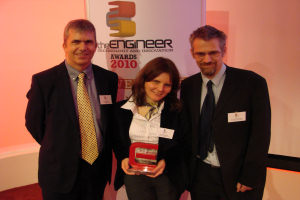Award for airport security scanner
22 Dec 2010
The University of Manchester has scooped a prestigious prize for a 3D airport scanner which can dramatically improve luggage security.

Professor Bill Lionheart and his team, working with security firm Rapiscan, won the Defence and Security prize at The Engineer’s Technology & Innovation Awards.
Hosted by Robert Llewellyn, best known for his role as Kryten in Red Dwarf and from Scrapheap Challenge – the awards acknowledged engineering excellence emanating from collaborative engineering projects in ten categories.
The RTT80 3D scanner, which has been tested at Manchester Airport and by the US Government, combines the very high quality 3D data of a CT image with the high speed of an X-Ray system to detect potential explosives in the baggage of airline passengers.
At the moment, suitcases and large bags go through large X-ray systems and are sent to a second line of security if anything suspicious shows up – a CT scan, similar to those used in hospitals.
This double-layered security system is slow and requires extra operators, so the scanner was designed to replace the current layered system with a single CT scan.
Kenn Mann, Technical Director of Aviation Security at Rapiscan, said: “We expect the RTT to be a step change in baggage screening, bringing the highest detection performance at the fastest speeds.
“Our collaboration with The University of Manchester has been a great success and has produced some very impressive results.”
The RTT80 produces a 3D image of the contents of a case or bag in the same time as a conventional projection X-ray system’s 2D image
To achieve this, Rapiscan turned to Professor Lionheart, an applied mathematician at The University of Manchester.
Professor Lionheart realised that in this innovative new type of X-ray scanner the basic mathematics behind forming a 3D image was not yet known. Funded by a grant from the Engineering and Physical Sciences Research Council and Rapiscan, Professor Lionheart assembled a team to work on various aspects of the problem.
Dr Marta Betcke joined the team and together they devised an algorithm based on multiple surfaces to reconstruct the image in real time, so that it can be viewed by an operator. A patent has been filed and the method tested on data collected at the airport. A production prototype of the RTT 80 is currently being tested by regulatory authorities.
Meanwhile the systems little brother, the prototype RTT20 is installed at the University where Lionheart and collaborators plan to use it for basic science.
Professor Lionheart says: “This project shows what can be done when mathematicians work closely with engineers in industry on problems that require new mathematics but are immediately applicable.
“The RTT80 is a great example of British innovation and we are proud to have been part of it. As well as making air travel safer real time X-ray scanners have enormous potential in other applications.”
